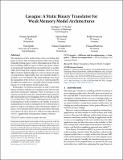Files in this item
Lasagne : a static binary translator for weak memory model architectures
Item metadata
| dc.contributor.author | Rocha, Rodrigo C. O. | |
| dc.contributor.author | Sprokholt, Dennis | |
| dc.contributor.author | Fink, Martin | |
| dc.contributor.author | Gouicem, Redha | |
| dc.contributor.author | Spink, Tom | |
| dc.contributor.author | Chakraborty, Soham | |
| dc.contributor.author | Bhatotia, Pramod | |
| dc.date.accessioned | 2022-09-07T12:30:01Z | |
| dc.date.available | 2022-09-07T12:30:01Z | |
| dc.date.issued | 2022-06-09 | |
| dc.identifier | 278807512 | |
| dc.identifier | b5616bee-7962-4f57-937d-a59d46788ae4 | |
| dc.identifier | 85132294823 | |
| dc.identifier | 000850435600059 | |
| dc.identifier.citation | Rocha , R C O , Sprokholt , D , Fink , M , Gouicem , R , Spink , T , Chakraborty , S & Bhatotia , P 2022 , Lasagne : a static binary translator for weak memory model architectures . in Proceedings of the 43rd ACM SIGPLAN International Conference on Programming Language Design and Implementation (PLDI 2022) . ACM , pp. 888–902 , 43rd ACM SIGPLAN Conference on Programming Language Design and Implementation (PLDI 2022) , San Diego , California , United States , 13/06/22 . https://doi.org/10.1145/3519939.3523719 | en |
| dc.identifier.citation | conference | en |
| dc.identifier.isbn | 9781450392655 | |
| dc.identifier.other | ORCID: /0000-0002-7662-3146/work/118799805 | |
| dc.identifier.uri | https://hdl.handle.net/10023/25964 | |
| dc.description | Funding: This work was supported by a UK RISE Grant. | en |
| dc.description.abstract | The emergence of new architectures create a recurring challenge to ensure that existing programs still work on them. Manually porting legacy code is often impractical. Static binary translation (SBT) is a process where a program’s binary is automatically translated from one architecture to another, while preserving their original semantics. However, these SBT tools have limited support to various advanced architectural features. Importantly, they are currently unable to translate concurrent binaries. The main challenge arises from the mismatches of the memory consistency model specified by the different architectures, especially when porting existing binaries to a weak memory model architecture. In this paper, we propose Lasagne, an end-to-end static binary translator with precise translation rules between x86 and Arm concurrency semantics. First, we propose a concurrency model for Lasagne’s intermediate representation (IR) and formally proved mappings between the IR and the two architectures. The memory ordering is preserved by introducing fences in the translated code. Finally, we propose optimizations focused on raising the level of abstraction of memory address calculations and reducing the number offences. Our evaluation shows that Lasagne reduces the number of fences by up to about 65%, with an average reduction of 45.5%, significantly reducing their runtime overhead. | |
| dc.format.extent | 15 | |
| dc.format.extent | 890457 | |
| dc.language.iso | eng | |
| dc.publisher | ACM | |
| dc.relation.ispartof | Proceedings of the 43rd ACM SIGPLAN International Conference on Programming Language Design and Implementation (PLDI 2022) | en |
| dc.subject | Binary translation | en |
| dc.subject | Memory model | en |
| dc.subject | Compiler | en |
| dc.subject | QA75 Electronic computers. Computer science | en |
| dc.subject | DAS | en |
| dc.subject | NIS | en |
| dc.subject.lcc | QA75 | en |
| dc.title | Lasagne : a static binary translator for weak memory model architectures | en |
| dc.type | Conference item | en |
| dc.contributor.institution | University of St Andrews. School of Computer Science | en |
| dc.identifier.doi | https://doi.org/10.1145/3519939.3523719 | |
| dc.date.embargoedUntil | 2022-06-13 | |
| dc.identifier.url | http://sigplan.org/OpenTOC/ | en |
This item appears in the following Collection(s)
Items in the St Andrews Research Repository are protected by copyright, with all rights reserved, unless otherwise indicated.

